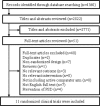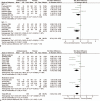Efficacy and feasibility of antidepressant treatment in patients with post-stroke depression
- PMID: 27828858
- PMCID: PMC5106064
- DOI: 10.1097/MD.0000000000005349
Efficacy and feasibility of antidepressant treatment in patients with post-stroke depression
Abstract
Background: Depression greatly impacts the quality of life in most stroke survivors. Therefore, effective treatment of post-stroke depression (PSD) is critically important. However, evidence supporting the effectiveness and feasibility of antidepressant treatment in this population is limited and somewhat confusing.
Methods: A comprehensive literature search of the Cochrane, PubMed, Web of Science, and Embase databases from inception up to November 2015 was conducted. We reviewed all randomized controlled trials (RCTs) that assigned patients with a clinical diagnosis of PSD to antidepressant or placebo treatment. Reduction in depression rating scale scores and response rate to antidepressants were defined as the efficacy outcomes. Rates of dropout for any reason and for adverse effects were defined as the acceptability outcomes. We also assessed improvements in activities of daily living (ADL) as functional outcomes.
Results: In total, 11 trials consisting of 740 participants were indentified. A significant advantage of antidepressants compared with placebo treatment in PSD was observed in overall pooled effect size analysis (SMD = -0.96; 95% CI = -1.41 to -0.51; P <0.0001). In addition, patients receiving antidepressants presented a much greater improvement in various depressive symptoms than those with placebo (RR = 1.36; 95% CI = 1.01-1.83; P = 0.04). However, antidepressants were less well tolerated than placebo because of some adverse events (RR = 2.72; 95% CI = 1.37-5.43; P = 0.04). Intriguingly, no consistent evidence was found for a positive effect of antidepressants on ADL in our analysis.
Conclusions: This meta-analysis suggests that antidepressants treatment confers potentially positive effects in patients with PSD as compared with simple placebo treatment. However, this must be carefully considered in light of its possible adverse events in some individual patients.
Conflict of interest statement
The authors have no conflicts of interest to disclose.
Figures







References
-
- Hackett ML, Yapa C, Parag V, et al. Frequency of depression after stroke: a systematic review of observational studies. Stroke 2005; 36:1330–1340. - PubMed
-
- Gaete JM, Bogousslavsky J. Post-stroke depression. Expert Rev Neurother 2008; 8:75–92. - PubMed
-
- Esparrago Llorca G, Castilla-Guerra L, Fernandez Moreno MC, et al. Post-stroke depression: an update. Neurologia 2015; 30:23–31. - PubMed
-
- Angelelli P, Paolucci S, Bivona U, et al. Development of neuropsychiatric symptoms in poststroke patients: a cross-sectional study. Acta Psychiatr Scand 2004; 110:55–63. - PubMed
Publication types
MeSH terms
Substances
LinkOut - more resources
Full Text Sources
Other Literature Sources
Medical

